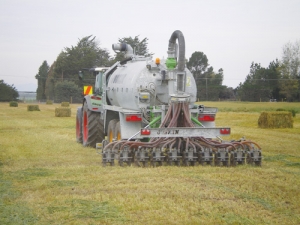Piggery effluent polluting stream
Waikato Regional Council has sought an interim Enforcement Order from the Environment Court to stop piggery effluent from entering a waterway north of Te Aroha.
 Injecting dairy effluent directly into soil has been found as the most efficient way of applying, with the least N losses.
Injecting dairy effluent directly into soil has been found as the most efficient way of applying, with the least N losses.
New Zealand's farmers seem to have at last woken up and smelt the coffee.
They're realising that farmyard manure and dairy effluent have exceptional fertiliser value, and used wisely can greatly reduce inputs.
Many set-ups, particularly in the dairy sector, are being forced to meet increasingly tough environmental standards applied by local authorities; they are rightly concerned about runoff, groundwater contamination and destruction of local habitat.
Most 'new builds' must have a storage system to hold the effluent produced, particularly in wet seasons, and where ground conditions do not lend themselves to heavy traffic.
Unfortunately, the traditional method of application, centred on 'put it on thick lads, she'll be right' can result in two-thirds of the available N value being lost as ammonia emissions, losing the best part of the fertiliser value.
So it might pay to follow a lead from Europe: trials set up by the European Commission in 2013 looked at alternative methods of application and explored the best ways to reduce ammonia emissions.
These trials identified basically four ways to apply dairy liquid manures or slurries: the 'slap it on method', which resulted in losses of available N of up to 70%; application by dribble hose or trailing shoe applicators (losses 40% and 30% respectively); and shallow injection down to about 100mm (losses only 10%).
The findings mirror those in the Netherlands, which in the 1990s imposed mandatory injection for grassland. The results: ammonia emissions fell from 220 million kg in 1992 to 70 million by 1996 and 40 million kg by 2013.
So that foul smelling deposit excreted by Old Daisy – more often than not in the dairy shed when you're not looking – has serious potential to reduce input costs in these troubled dairy times. Stored properly and used wisely, with decent soil sampling en route, should help keep some businesses in the black.
Fonterra has cemented its position as the country’s number one cheesemaker by picking up nine NZ Champion of Cheese trophies this year.
New Zealand dairy processors are welcoming the Government’s commitment to continuing to push for Canada to honour its trade commitments.
An educational programme, set up by Beef + Land New Zealand, to connect farmers virtually with primary and intermediate school students has reported the successful completion of its second year.
The Food and Agriculture Organisation of the United Nations (FAO) has welcomed a resolution adopted by the United Nations (UN) General Assembly to declare 2026 International Year of the Woman Farmer.
Waikato herd health veterinarian Katrina Roberts is the 2024 Fonterra Dairy Woman of the Year.
Horticulture NZ chief executive Nadine Tunley will step down in August.